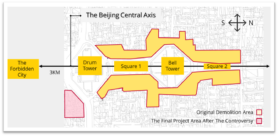Beijing: Bell and Drum Tower Area Regeneration

The residential area initially involved in the BDTA regeneration project (drawn according to interviewee’s records)
Introduction
The Bell and Drum Tower area (BDTA) is located in the center of Beijing and is part of the city’s historic and cultural zone. The Bell and Drum Towers are important markers of ancient Chinese urban planning and sit on Beijing’s Central Axis, a 7.8 km stretch that runs through the city’s core. The redevelopment of this area has thus involved not only urban renewal but also the protection of historical and cultural heritage. A renewal project, known as the “Restoration and Improvement of Bell and Drum Tower Square,” officially started in 2010, aiming to improve infrastructure and living conditions in the area. However, the project quickly became controversial due to concerns over heritage preservation. It also attracted a variety of different opinions from residents. Our research investigate whether and how social media empowers citizens, experts, journalists, and civil society organizations to influence decision-making and promote a collaborative planning process.

Uncluttered square in BDTA

Utilitarian housing in a neighboring hutong
(1) Initial Project: 2009-2011
The initial plan, led by the Dongcheng District Government and Boston Design International Group, aimed to commercialize the area by building a “Time Culture City,” including shopping malls and upscale housing. This plan sparked strong opposition from cultural heritage experts and civil society organizations, who feared it would severely damage the historic surroundings of the Bell and Drum Towers. Organizations like the Beijing Cultural Heritage Protection Center used social media to protest, which eventually led the government to cancel the project.
(2) Project Adjustment and Restart: 2012-2013
After canceling the original commercial project, the Dongcheng District Government launched a revised plan with a focus on restoring illegal structures around the Bell and Drum Towers. Despite scaling down commercial ambitions, the project still faced considerable criticism. Experts used social media platforms like Weibo to voice their concerns about the impact on cultural heritage, sparking wide public debate. Though the project moved forward, it continued to face opposition online.
(3) Project Implementation: 2013 onwards
In 2013, the government officially began demolishing illegal structures and relocating residents. However, the project’s scope exceeded the original announcement, leading to further protests. An unregistered civil society organization monitored the demolition process and used social media to expose potential misconduct. Despite their efforts, the demolitions continued, and parts of the historic landscape were altered.

